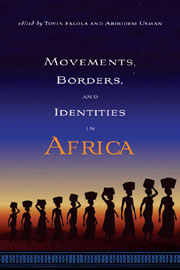Book contents
- Frontmatter
- contents
- Preface
- Introduction: Migrations in African History: An Introduction
- PART A State Formation and Migration Crossroads
- 1 Frontier Migrations and Cultural Transformations in the Yoruba Hinterland, ca. 1575–1700 The Case of Upper Osun
- 2 The Root Is Also Here: The Nondiaspora Foundations of Yoruba Ethnicity
- 3 Settlement Strategies, Ceramic Use, and Factors of Change among the People of Northeast Osun State, Nigeria
- 4 Precolonial Regional Migration and Settlement Abandonment in Yorubaland, Nigeria
- 5 Migrations, Identities, and Transculturation in the Coastal Cities of Yorubaland in the Second Half of the Second Millennium: An Approach to African History through Architecture
- PART B Movements and Identities
- List of Contributors
- Index
2 - The Root Is Also Here: The Nondiaspora Foundations of Yoruba Ethnicity
from PART A - State Formation and Migration Crossroads
Published online by Cambridge University Press: 12 September 2012
- Frontmatter
- contents
- Preface
- Introduction: Migrations in African History: An Introduction
- PART A State Formation and Migration Crossroads
- 1 Frontier Migrations and Cultural Transformations in the Yoruba Hinterland, ca. 1575–1700 The Case of Upper Osun
- 2 The Root Is Also Here: The Nondiaspora Foundations of Yoruba Ethnicity
- 3 Settlement Strategies, Ceramic Use, and Factors of Change among the People of Northeast Osun State, Nigeria
- 4 Precolonial Regional Migration and Settlement Abandonment in Yorubaland, Nigeria
- 5 Migrations, Identities, and Transculturation in the Coastal Cities of Yorubaland in the Second Half of the Second Millennium: An Approach to African History through Architecture
- PART B Movements and Identities
- List of Contributors
- Index
Summary
This chapter is a contribution to the debate on the origin of pan-Yoruba ethnicity. There are two points of view. One is that an age-old ethnic consciousness existed, deriving from the supranational state (Lucumi or Nago) headquartered at Ile-Ife, from which other communities derived their ancestry, related political systems, and linguistic affinities. A more widespread view counters this, tracing the ethnic consciousness to the era of the Atlantic slave trade, when it developed among enslaved Yoruba speakers in the diaspora. This view contends that, until the nineteenth century, Yorubaland was divided into several ethnicities, which underpinned the massive scale of warfare and enslavement in the region during the century. But as Yoruba speaking people who were sold into the Atlantic trade distinguished themselves from people of other cultures, there evolved, through a process of ethnogenesis, the Nago and Lucumi nations in the Americas (especially Brazil and Cuba) and the Aku (later the Yoruba) nation in Sierra Leone. That is, enslaved Yoruba speakers, like other migrants, searched for those who shared with them certain familiar identifiers: for example, religion (Orisa and Islam), urbanism, language, political organization, and certain facial markings, and formed a cohesive nationalism or Yoruba ethnic consciousness. Liberated slaves who returned home (and their outgrowth, the Lagos intelligentsia) introduced Yoruba-ness to those left behind. Their efforts were complemented by those of Christian missionaries and British colonialists, who, because this new identity met their idea of “nationhood” and a new sociopolitical order, propagated it.
- Type
- Chapter
- Information
- Movements, Borders, and Identities in Africa , pp. 53 - 80Publisher: Boydell & BrewerPrint publication year: 2009



